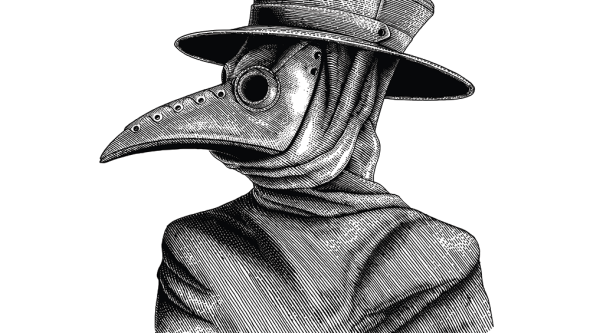
Gonzalo Díaz Ponce
The Black Death (or Bubonic plague) devastated Europe between 1347 and 1351, and it killed more lives than any war or other epidemic known to date. This plague took the lives of many people and incidentally discredited the church which, at that time, it was going through a big crisis due to an incipient Protestant thought. A disease that undoubtedly makes us reflects on what is happening today with COVID-19 (Coronavirus), which is already having a huge impact on a large number of countries.
Let’s review the case of the Black Death case and then analyze the coronavirus case:
The Black Death
Etymology
It had several names, but the most popular was “Black Death” coined by English language. However, it was also called ” Great Pestilence”, “Black plague”, or simply ”Pestilence”. It is named “black” because of the blackening of the skin that people suffered.
Causes
It was originated from the bacillus (bacteria) called Yersinia pestis. This bacillus was found in rats since this plague came from a natural rodent’s disease; therefore, rodents became an important vehicle for this disease. Most rats die from it and only some of them survive.
However, rats are not the main carrier strictly speaking, but it is a flea called Xenopsylla Cheopis, or “rat flea”. This flea feeds itself through the bites inflicted on rodents, extracting all the disease and taking it with it. Once it ingests all the bacteria, the flea goes to another rodent to feed itself and in the process infects another animal.
Due to the constant death of rodents, the flea cannot find another receptor to feed itself, being man the only receptor.
These rodents are native to China, but when rodents in Asia begin to emigrate to dry grasses, they head towards Europe, as this region was more populous and leafy. The Silk Road could also be considered as a mean by which rats and infected travelers have spread the disease for all Europe.
Other sources say it was spread when the Kipchak (Turkish nomads) people besieged Genoese trading posts in Crimea, so the plague was spread among the corpses left after the siege.
The disease spread from Mediterranean arrived to the following cities:
- Sicily (1347)
- North Africa, Italy, Spain, England and France (1348)
- Austria, Hungary, Switzerland, Germany and the Netherlands (1349)
- Scandinavia and the Baltic Lands (1350)
However, the disease reached many more areas and lasted until 1353.
Symptoms
The Black Death had the following symptoms:
- Coughing up blood
- Short of breath
- Vomiting
- High fever
- Headache
These symptoms appeared days after the bacteria have taken up residence.
Plague affection
The Black Death plague mortality rate varies from place to place. Thus, the Duchy of Milan, Flanders and Bearn were able to be safe from the plague comparatively if they are contrasted with Tuscany, Aragon, Catalonia and Languedoc, which had a harder impact.
Urban towns suffered the most in contrast to rural towns. However, a high mortality rate was found was in monasteries. The reason was that Christian monks (among other religions) strongly trusted their religious convictions, believing that nothing serious would happen to them.
Even the great monarchs could not escape this disease. This is the list of those who didn’t survive:
- Eleanor, queen of Pedro IV of Aragon
- Alfonso XI de Castilla, great-grandson of Alfonso X the wise.
- Joan, daughter of the English King Edward III, who died on the way to her own wedding
- John of Stratford, Archbishop of Canterbury
- Thomas Bradwardine, philosopher of Canterbury
- Guillermo de Ockham (although his death is still doubted)
These are just a few examples of the best known characters that were killed by the Black Death.
Statistics
The contemporary study of the archives of the time suggests a variant mortality in the different regions between 1/8 and 2/3 of the population. French chronicler Jean Froissart said that a third of Europe’s population died in the epidemic. The population in England in the year 1400 was compared to 100 years ago, and, as the plague reached the country, 1000 villages disappeared.
Around 75,000,000 to 200,000,000 people died in Europe during the Black Death. The population fell from 475 million to 350 million. That means 30% of the population inevitably fell into this disease.
It took 200 years for Europe to recover from the plague, although in some areas of Italy the plague continued until the 19th century and even entering the 20th century there were already some cases with the same disease.
Consequences
The consequences were multiple. On one hand, wars stopped, but also commercial transport. Thousands of people died and the fields were abandoned due to peasants’ death whose corpses were infected. Consequently, it led to the ruin of the landowners.
There were also psychological problems, as people lived in fear of death. Many began to incorporate mysticism in their philosophical theories, and even opted for magic and spells.
The Dominicans (religious monks) reduced their members drastically and this forced them to incorporate priests with little experience and studies. In fact, many of the theological or ecclesiastical schools found themselves in the same problem, resulting in an intellectual decline; for the majority of the population no longer believed in the church and they turned to superstitions and heresies.
One of the best known superstitions was crossing in front of a black cat. Black cats were said to be witches who disguised themselves at night for which they were persecuted. Because of being independent and poorly obedient to man’s orders, these cats were also considered to be associated with the devil.
The church had veracity power as early as the fourteenth century, but failing to deal with the black plague phenomenon, its credibility was greatly affected. That’s when the reformers pointed out that the church was to blame for the disease spreading further
Coronavirus (COVID-19)
Etymology
The true name of this pandemic is orthocoronavirinae that comes from Latin. As a matter of pragmatism, the virus is called ” Coronavirus ”, since the appearance of the virus is similar to a crown (coronam means ‘’crown’’ in Latin), although, more than a crown as used by kings, it is more similar to a solar corona: an eclipse-like weather phenomenon.
Origin
One of the interesting points they have in common is that both diseases were originated from Asia. People say Coronavirus was originated from the bat-blood stew, while others say it was through the pangolin. These two animals were illegally sold in the Wuhan region of China. In fact, the pangolin coronavirus is said to be 99% identical to the virus that affects so many countries today. However, in February the pangolin was already discarded, and the bat was considered the virus carrier.
Symptoms
Coronavirus symptoms resemble some of the Black Death.
- Cough
- Fever
- Breathing difficulties
- Shaking chills
- Secretion
Consequences
Although it is extremely difficult to make a comparison between the black plague and the coronavirus, since the latter has not yet defined all its consequences and statistics, we can say that economic factors are indeed crucial. For commerce it was a catastrophe because many merchants had to close their businesses by authorities’ decisions. The ports did not allow ships or goods to enter, something similar to what is happening now, especially with cruise ships.
In the fourteenth century, medicine was scarce and knowledge of disease was also scarce, even though they had already had some experience with the Justinian plague. Today, with advanced medical technology, the measures taken regarding the virus are much better. China has already reduced the number of those infected in recent months, so the origin of the outbreak would no longer expand in the country. However, all those tourists who traveled to China and returned to their countries will have to undergone to the measures taken in their respective countries.
Death toll from the novel coronavirus is 314.000 (May 2020) and a total of 4.7 million confirmed cases worldwide. The Black Death lasted 7 years and left its remnants with the bubonic plague until 20th century. We do not know how far it can continue, but we hope that medical advances can slow it down in less time than its predecessor.
Psychological aspect was also important. Diseases have always been taken as a kind of spontaneous phenomenon where man does not necessarily have control. However, there is also the way of thinking that this was artificially created, or at least created for some political purpose. If this is so, could it be that all diseases have been created to spread a collective panic?



